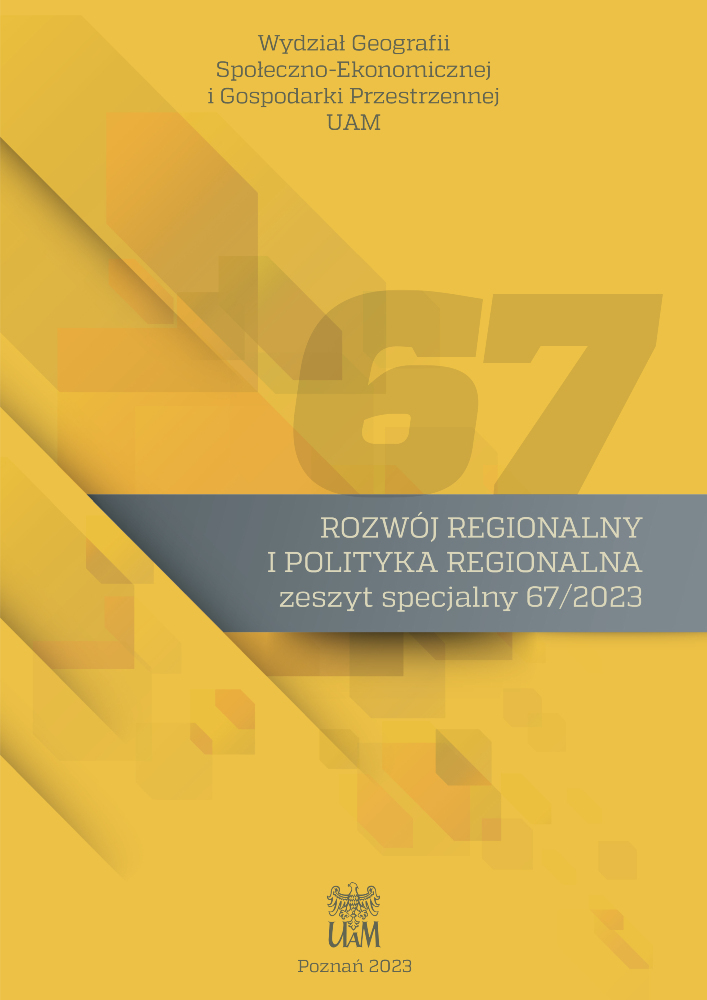Abstract
The COVID-19 pandemic has had an impact on the functioning of the world economy. The lockdowns introduced several times and the related restrictions on the freedom of movement of the population and the suspension of the activities of most tourist enterprises had a negative impact on the functioning of the tourism sector, especially in those areas whose development is strongly related to tourist services.
This study analyzes changes in the functioning of tourism development and traffic in the coastal tourist zone in connection with the COVID-19 pandemic. Data from the Local Data Bank of the Central Statistical Office (GUS) in the field of selected indicators and measures of tourism development and traffic in communes and poviats of the coastal tourist zone BY the Baltic Coast were used.
The results of the study indicate that the COVID-19 pandemic and the related sanitary and epidemic restrictions have had a significant impact on the tourism industry. To a much greater extent, the impact of the COVID-19 pandemic was visible in the values of measures and indicators describing tourism, and to a lesser extent in the values of measures and indicators relating to tourism development. The changes affected the tourist development to a small extent. The variability in the number of facilities and bed places was marked to a small extent, most in the communes of Puck, Nowodworski and Kołobrzeg, and to the smallest extent in the municipal poviats: Gdynia, Gdańsk, Sopot and in the Wejherowo poviat.
A much higher degree of variability concerned selected measures and indicators of tourist traffic,
i.e. the number of overnight stays and the number of overnight stays, both for domestic and foreign tourists.
The highest was in the districts of Kamień, Kołobrzeg and the cities of Świnoujście and Sopot.
In most municipalities and coastal districts, a clear compensation of tourist traffic is recorded in the post-pandemic period, which is expressed in significantly increased indicators of the number of overnight stays and the number of overnight stays.
At the same time, there are communes where the downward trend in the number of tourists and the number of overnight stays during the COVID-19 pandemic continues in subsequent years.
References
Adinolfi M.C., Harilal V., Giddy J.K. 2020. Travel stokvels, leisure on lay-by, and pay at your pace options: The post COVID-19 domestic tourism landscape in South Africa. African Journal of Hospitality, Tourism and Leisure, 10(1): 302-317. DOI: https://doi.org/10.46222/ajhtl.19770720-102
Chang C.L., McAleer M., Ramos V.A. 2020. Charter for sustainable tourism after COVID-19. Sustainability, 12, 3671. DOI: https://doi.org/10.3390/su12093671
Collins-Kreiner N., Ram Y. 2020. National tourism strategies during the COVID-19 pandemic. Annals of Tourism Research, 103076.
Deb S.K., Nafi S.M. 2020. Impact of COVID-19 pandemic on tourism: Recovery proposal for future tourism. GeoJournal of Tourism and Geosites, 33(4 Supplement): 1486-1492. DOI: https://doi.org/10.30892/gtg.334spl06-597
Hall C.M., Scott D., Gössling S. 2020. Pandemics, transformations and tourism: Be careful what you wish for. Tourism Geographies, 22(3): 577-598. DOI: https://doi.org/10.1080/14616688.2020.1759131
Kowalczyk-Anioł J., Pawlusiński R. 2021. Miasto turystyczne wobec pandemii COVID-19. Pierwsze doświadczenia w świetle literatury przedmiotu. Annales Universitatis Mariae Curie-Skłodowska Lublin-Polonia, 76: 203-222. DOI: https://doi.org/10.17951/b.2021.76.0.203-222
Kowalska K., Niezgoda A. 2020. COVID-19 as a Tourist Activity Inhibitor as Evidenced by Poles’ Holiday Plans. Studia Periegetica, 4(32): 9-24. DOI: https://doi.org/10.5604/01.3001.0014.6526
Kreiner N.C., Ram Y. 2021. National tourism strategies during the Covid-19 pandemic. Annals of Tourism Research, 89, 103076. DOI: https://doi.org/10.1016/j.annals.2020.103076
McCartney G. 2020. The impact of the coronavirus outbreak on Macao. From tourism lockdown to tourism recovery. Current Issues of Tourism, 2683-2692. DOI: https://doi.org/10.1080/13683500.2020.1762549
Meng Y., Khan A., Bibi S., Wu H., Lee Y., Chen W. 2021. The effects of COVID-19 risk perception on travel intention: Evidence from Chinese Travelers. Frontiers in Psychology, 12, 655860. DOI: https://doi.org/10.3389/fpsyg.2021.655860
Mensah E.A., Boakye K.A. 2021. Conceptualizing post-COVID 19 tourism recovery: A three-step framework. Tourism Planning & Development, 1-25. DOI: https://doi.org/10.1080/21568316.2021.1945674
Milano C., Novelli M., Cheer J.M. 2019. Overtourism and tourismphobia: A journey through four decades of tourism development, planning and local concerns. Tourism Planning & Development, 16(4): 353-357.
Napierała T., Leśniewska-Napierała K., Burski R. 2020. Impact of Geographic Distribution of COVID-19 Cases on Hotels’ Performances: Case of Polish Cities. Sustainability, 12(11), 4697. DOI: https://doi.org/10.3390/su12114697
Obłąkowska K.A. 2022. Sektor turystyczny w Polsce w przededniu i obliczu pandemii COVID-19. Sport i Turystyka. Środkowoeuropejskie Czasopismo Naukowe, 5, 2: 117-137. DOI: https://doi.org/10.16926/sit.2022.02.07
Owsiak J., Sewerniak J. 1980. Geograficzne podstawy użytkowania turystycznego strefy nadmorskiej. Instytut Turystyki, Warszawa.
Panasiuk A. 2020. Przyczynek do badań nad wpływem pandemii na stan gospodarki turystycznej. Turystyka w Naukach Społecznych, 3: 55-70.
Sadecki W. 2022. Wpływ pandemii COVID-19 na podróże służbowe w branży małych i średnich przedsiębiorstw. Studia Periegetica, 2(38): 47-62. DOI: https://doi.org/10.5604/01.3001.0015.9324
Sigala M. 2020. Tourism and COVID-19: Impacts and implications for advancing and resetting industry and research. Journal of Business Research, 117: 312-321. DOI: https://doi.org/10.1016/j.jbusres.2020.06.015
Sztuk A. 2021. Zmiany w wyborach destynacji turystycznych w okresie pandemii COVID-19: szansa dla małych miast. [W:] W. Nowak, K. Szalonka (red.), Zdrowie i style życia. Ekonomiczne, społeczne i zdrowotne skutki pandemii. Wydawnictwo Uniwersytetu Wrocławskiego, Wrocław, s. 155-176.
Walas B., Kruczek Z. 2020. The impact of COVID-19 on tourism in Kraków in the eyes of tourism entrepreneurs. Studia Periegetica, 2: 79-95. DOI: https://doi.org/10.5604/01.3001.0014.3664
Zajadacz A. (red.) 2021. Uwarunkowania i plany rozwoju turystyki. T. 13: Zmiany w budżecie czasu wolnego i zachowaniach wolnoczasowych mieszkańców dużych miast w wyniku pandemii viCOVID-19. Bogucki Wydawnictwo Naukowe, Poznań.
License
Copyright (c) 2023 Krzysztof Parzych, Arkadiusz Ciupek

This work is licensed under a Creative Commons Attribution 4.0 International License.

